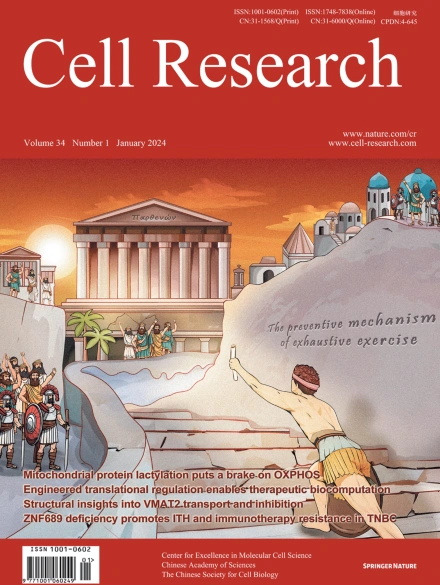
Advanced Search
Submit Manuscript
Advanced Search
Submit Manuscript
Volume 34, No 1, Jan 2024
ISSN: 1001-0602
EISSN: 1748-7838 2018
impact factor 17.848*
(Clarivate Analytics, 2019)
Volume 34 Issue 1, January 2024: 13-30 |
Hypoxia induces mitochondrial protein lactylation to limit oxidative phosphorylation
Yunzi Mao1,† , Jiaojiao Zhang1,† , Qian Zhou1,† , Xiadi He1,2,3,† , Zhifang Zheng1 , Yun Wei1,2,3 , Kaiqiang Zhou1 , Yan Lin1,4,5 , Haowen Yu1 , Haihui Zhang1 , Yineng Zhou1 , Pengcheng Lin6 , Baixing Wu7 , Yiyuan Yuan1,4 , Jianyuan Zhao1,4 , Wei Xu1,4,5,* , Shimin Zhao1,4,6,*
1The Obstetrics & Gynecology Hospital of Fudan University, Shanghai Key Laboratory of Metabolic Remodeling and Health, State Key Laboratory of Genetic Engineering, School of Life Sciences, Children’s Hospital of Fudan University, and Institutes of Biomedical Sciences, Fudan University, Shanghai, ChinaOxidative phosphorylation (OXPHOS) consumes oxygen to produce ATP. However, the mechanism that balances OXPHOS activity and intracellular oxygen availability remains elusive. Here, we report that mitochondrial protein lactylation is induced by intracellular hypoxia to constrain OXPHOS. We show that mitochondrial alanyl-tRNA synthetase (AARS2) is a protein lysine lactyltransferase, whose proteasomal degradation is enhanced by proline 377 hydroxylation catalyzed by the oxygen-sensing hydroxylase PHD2. Hypoxia induces AARS2 accumulation to lactylate PDHA1 lysine 336 in the pyruvate dehydrogenase complex and carnitine palmitoyltransferase 2 (CPT2) lysine 457/8, inactivating both enzymes and inhibiting OXPHOS by limiting acetyl-CoA influx from pyruvate and fatty acid oxidation, respectively. PDHA1 and CPT2 lactylation can be reversed by SIRT3 to activate OXPHOS. In mouse muscle cells, lactylation is induced by lactate oxidation-induced intracellular hypoxia during exercise to constrain high-intensity endurance running exhaustion time, which can be increased or decreased by decreasing or increasing lactylation levels, respectively. Our results reveal that mitochondrial protein lactylation integrates intracellular hypoxia and lactate signals to regulate OXPHOS.
https://doi.org/10.1038/s41422-023-00864-6